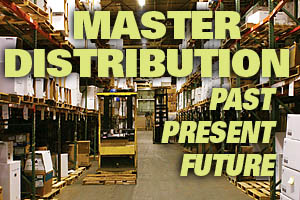
With all due respect to America's storied inventors and industrialists, they weren't so unique. Many of the world's greatest inventions hail from Europe or Asia, whose societies also have proven just as adept as the United States in manufacturing complex products.
The real secret to America's economic miracle has been our ability to distribute those goods to every nook and cranny of this vast land with an efficiency that makes them affordable to most citizens. It stems from our egalitarian heritage. Our nation did away with monarchy and treasures the ideal of equal opportunity. This differentiated us from most previous societies that developed the finest goods for the benefit of the noble classes without any thought of parceling them out to the masses.
Distribution always has been a highly entrepreneurial calling. No less inventive in their own way than the Thomas Edisons and Henry Fords of the world, pioneering distributors had a special knack for identifying and closing gaps in the supply chain. That, in a nutshell, is the story of master distributors in the PHCP industry.
Our industry's traditional channel of manufacturer-wholesaler-contractor/end user works well in the aggregate, but like any complex system, is riddled with chaos. Oddball items, short orders, imports, repair parts and other specialty goods don't fit snugly into the normal stream of commerce. Master distribution arose from a variety of origins to deal with these exceptions.
Some of the businesses, especially in the industrial PVF sector, evolved from surplus goods dealers. Others spun off from manufacturing firms - and the distinction between a manufacturer and a master distributor gets further blurred by private labeling on the part of many master distributors. Conventional wholesalers sometimes have evolved into master distributors as an outgrowth of their in-house central distribution activities or other circumstances. For instance, Palermo Supply Co. of Clifton, N.J., was a wholesaler supplying a bunch of home centers, which served as a springboard into master distribution servicing other wholesalers. Still others sprang from a repair parts niche ignored by the wholesaling community at-large.
“You can't sell from an empty wagon” used to be the slogan of virtually all PHCP wholesalers. As vendors and product lines proliferated, it became virtually impossible to buy everything offered. The typical PHCP wholesaler now must concentrate inventory dollars on the “A” and “B” fast movers. The “C” and D” items he buys from master distributors who stock everything offered but only in a handful of lines. Many of the master distributors we spoke with typically stock between 5,000-15,000 skus from a dozen or fewer vendors. Most conventional wholesalers carry tens of thousands of skus from hundreds of sources.
Our staff interviewed almost two dozen master distributors in preparing this special report. Some represent companies that were among the industry's earliest pioneers of master distribution. We also made it a point to speak with firms throughout the product range of our audience, spanning plumbing, high-end bathroom fixtures, repair parts, HVAC/hydronics and industrial PVF.
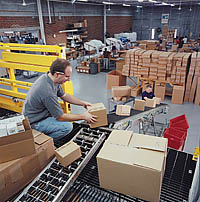
Roots Of Master Distribution
Specialty Valve & Fitting Co. of Paramount, Calif., is among those whose roots lay in the old surplus inventory business that arose in the post-World War II era. Back then, materials were harder to come by and distribution less reliable than today. So contractors on big construction projects were compelled to overbuy material - especially industrial PVF - to be sure they had enough for the job at hand. When it was finished, they usually had plenty left over, which they'd seek to unload at cut-rate prices.“There weren't many wholesalers at the time, so there was no role for a master distributor,” says Specialty's President Hal Spear. “But as time passed our wholesaler customer base grew, and we started sourcing materials from factories as well as buying surplus. At that point we decided to specialize in selling strictly to wholesalers who inventory product.”
Founded in 1947, Industrial Valco of Compton, Calif., is another PVF master distributor with roots in surplus inventory. Founder Charles “Nick” Nichols began with surplus valves and valve repair service. According to Rob Raban, Nichols' grandson and current president, he wanted to expand into fittings, but major domestic producers such as Ladish and Tube Turn at the time had exclusive distribution agreements. “So he had to buy import fittings because those were the only people who would sell to him,” Raban says.
Warren Alloy also evolved out of the surplus business. Now it is a master distributor of stainless and alloy fittings, but also manufactures its own line of valves, keeping the businesses separate.
In the plumbing sector, master distribution came about from a variety of circumstances. Firms such as Kissler Co. specialize in providing repair parts, some of which are obsolete and require machining to order by the master distributor. “I don't see many people entering this business,” says President Barry Kissler. “We track about 20,000 different product numbers, and that's pretty hard to manage.”
Corona, N.Y.-based Wal-Rich Corp. has been around since 1950 as a hybrid manufacturer/master distributor of plumbing, heating and industrial specialties. “Product selection, price and lead time are the most important factors in master distribution, as well as expertise in the line,” notes Andrew Rich, the company's vice president/sales.
Kolson is a master distributor of high-end bathroom accessories. Its business grew out of an early company history in the hardware business and a retail showroom that still exists as a separate division. “Much of our business comes from recommendations by the manufacturers we carry,” says Vice President Dale Landy. “If they don't have something to ship, they tell people to buy it from Kolson.”
Hirsch National Sales is an example of a master distributor that sprang from a conventional plumbing wholesaler. Based in the Los Angeles area, it helped pioneer master distribution by carrying an extensive inventory of Chicago Faucets and Sloan Flush Valves back when those companies had long West Coast lead times. It has since expanded into various other plumbing lines.
Matco-Norca, started in 1952, is a master distributor whose roots lay in importing. According to the founder's son Dove Matz, “in the early years, the market was small for imported products. People just didn't accept them. But over the years that changed.”
Ta Chen started as a Taiwan manufacturer of steel pipe in 1986. It has since expanded into a master distributor of stainless fittings and flanges as well as pipe. About a third of the products it distributes come from Ta Chen's own mills.
Merit Brass, too, evolved from a manufacturing business. The company started out in 1937 making brass pipe nipples and soon began master distributing brass fittings and other items. Over time it added stainless steel nipples to its manufacturing capabilities, and also transitioned into the master distribution of related stainless PVF. “We were one of the first master distributors in the business,” says Vice President Alan Lipp, “although that wasn't the term back then. People called them 'super-wholesalers.'” In addition to the nipples it continues to manufacture, Merit private labels some of the goods it distributes.
Long Beach, Calif.-based BAVCO has one of the narrowest niche businesses in the master distribution field. It descends from a plumbing contractor who later specialized in backflow prevention and testing, where repair parts were hard to come by.
“The average supply house wouldn't even know what they were,” says BAVCO President Jim Purzycki. “So we had to buy material from the manufacturers for our own service department. Soon, local plumbers found out we had the parts they needed, then wholesalers started calling us, too. We found out it was a lot easier dealing with one wholesaler than with 20 contractors in an area, so over time we built a business selling mostly to other wholesalers. Our claim to fame is 'every part for every assembly is in stock.' That's what keeps us in business.”
One of the newest master distribution ventures is The Distribution Point, located outside of Birmingham, Ala., which began operations in April 2003. According to President Ranson Roussel, the company has been privately funded by some 60 independent wholesalers, large and small, who brought the venture together in late 2002. Motivated in large measure by Home Depot's purchase of Your Other Warehouse, the wholesalers wanted to assure an independent source of supply for special orders.
The Distribution Point concentrates on some of the industry's premier faucet and fixture lines, including American Standard, Kohler, Elkay, Alsons, Moen, Delta, Sloan, Chicago Faucets, Grohe and Panasonic (bathroom fans). During its first year the firm sold mainly to its own investors, in order to work out any operational bugs before going to the industry at-large. Now it is in the beginning stages of selling to non-owner wholesalers. “During this first year, the reception from the wholesale community has been tremendous,” says Roussel, an industry veteran with experience at Morrison Supply and other wholesalers. “We have an all-star list of advisors and supporters, and the horsepower to make it happen. Best of all, we have an industry that is devoted to supporting its own.”
Many master distributors are situated on the West and Gulf coastal regions of our country. That's due to their heavy reliance on imports, especially in the industrial PVF sector. There also are quite a few based in the New York City/New Jersey area.
“The East Coast is littered with small independent wholesalers who need someone to fill their bins and keep their inventory manageable,” explains Tim Hagan of Kessler-Sunbelt Distribution in Paterson, N.J. His company started in the mid-1970s as a plumbing wholesaler. It started selling to other wholesalers around 1990, and a few years ago made the full transition to master distribution when it stopped dealing with contractors.
A master distributor has trouble gaining acceptance by wholesalers if it “plays both sides of the fence” by selling to its customers' customers. Most of those we spoke with insist they will not sell to contractors or other end users also served by the plumbing wholesalers who buy from them. Some may have other non-competing customer groups, such as OEMs or bath and kitchen dealers, but all of the master distributors cited here say that the vast majority of their business comes from this magazine's audience of PHCP wholesalers.
Wholesaler AF Supply, which operates in metropolitan New York and New Jersey, acts as a master distributor to other plumbing & heating wholesalers, some PVF distributors, kitchen and bath dealers and some specialty venues. However, it does not deal with big boxes, home centers or mass retailers. “Our current strategy does not facilitate our servicing those types of clients,” says Bennett Friedman, one of four family members who manages the seven-branch AF Supply Corp.
Dove Matz of Matco-Norca says his company sells a little into the hardware market, “but our specialty has really been with the wholesalers.”
“With retailers, price is the only issue. With wholesalers, quality counts. The professional plumber uses a lot, and if it doesn't work, the wholesaler will lose future business.”
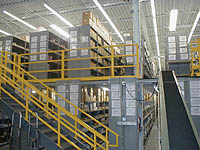
Today's Challenges
Master distributors fill the short order gap in the marketplace for wholesalers who can't or won't meet manufacturers' minimum order quantities. They typically register fewer line items per invoice than PHCP wholesalers, and in these ways resemble a retail business more than a wholesaler. Margins must be correspondingly higher than the conventional wholesaler's.Despite this somewhat different business model, master distributors face many of the same challenges as the industry's wholesalers. Competition is up, margins down, and profits largely contingent on cutting costs and improving efficiency.
In the old days, price was more of a secondary consideration in the business. Customers mainly patronized master distributors for goods in short supply in critical situations. Yet, today's marketplace offers multiple sources for almost everything, no matter how urgent.
“Competition comes at us every day from every angle,” remarks Bryan Cosentino, vice president of Metropac Industries, a master distributor of HVAC/R controls. “Every now and then there are even OEM customers of ours we end up competing against. Often they sell a product for less than we can purchase it.”
“The last four or five years have been absolutely brutal,” says Warren Alloy President Adam Finn. Slack demand coupled with increased competition in recent years has slashed the price of many industrial PVF goods to less than half of what they were 20 years ago. (The extraordinary run-up of PVF prices in early 2004 was occurring as we spoke, but still hadn't completely erased the deflationary trend of prior years.) “If not for continually increasing efficiencies in our business, we wouldn't be here,” Finn says.
Warren Alloy became one of the first master distributors certified to the new ISO 9000-2000 rating. Starting in the mid-'90s, the company looked at all of its procedures with an eye toward belt-tightening and eliminating mistakes. Today's company operates in accordance with the ISO platform, and undergoes continuous self-audits to reduce errors almost to zero.
Industrial Valco's Rob Raban told us he has responded to the PVF slump in part by reducing the square footage of warehouses, though not of inventory. “We now look at a warehouse and see every cubic foot as something we pay for. So instead of 14-foot aisles, we now have five-foot aisles in some places. We're also doing a lot more horizontal cross-racking. This is giving us a lot of cost savings in paying out leases,” Raban says.
Credit can be a problem for master distributors who sell nationwide, noted Jim Earls of Boston's industrial valve specialist Metropolitan Pipe & Supply Co. “It's sometimes hard to have your finger on the pulse of who's going to pay you and who's not. The local guys you know or hear stories about, but someone in the Midwest we may not hear about until it's too late,” says Earls.
Jeff Larsen, vice president of sales and marketing for Ta Chen, pointed to credit disruptions spurred by the recent run-up in commodity prices. “If you're doing $100,000 worth of PVF business with someone, that business will be $130,000-140,000 the next time he orders. Is he good for the extra amount? Also, when you're buying inventory, what used to cost $50 million may cost $70 million next time, but the bank only sees $30 million in invoices and may not cut you any slack. In the short-term, the upsurge in commodity prices may be good for us, but this is its challenging side,” Larsen says.
It seems that every technological advance since the discovery of fire embodies the potential for good and evil uses. Several master distributors saw that parallel in the fax machine.
“I'm glad there are fax machines, because it's a bonus to receive information quickly and concisely. But in another way, it's pretty much ruined our industry,” comments Hal Spear of Specialty Valve & Fitting. “Before you had the ability to fax, you knew a handful of vendors who may have the material in stock, and you'd call one or two of them. If you had a really large bill of goods to order, you'd have to mail it, or read it over the phone and it would take an hour.
“Now, you can load 30 numbers into the speed dial and send every $100 quote to 30 people. It's happened at every level of distribution, and changed the face of our industry into something de-personalized and totally price oriented. You can't really familiarize yourself with 30 vendors, but you can fax them all in a matter of seconds,” says Spear.
“Another problem is how to control overhead costs,” says AF Supply's Bennett Friedman. “This is especially challenging for a company that is trying to compete nationally while distributing from an area like New York City, where the cost of labor and distribution facilities is significantly higher than in other parts of the country,” he points out.
Master distributors are further challenged by the need to keep inventory current with all the quick changes in design, finish, fashion, style and color, Friedman says.
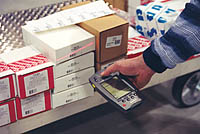
Expertise & Service
Having product is, of course, the most fundamental duty of a master distributor. Its other main selling proposition is expertise. By concentrating on a smaller range of product than their wholesaler customers, master distributors tend to acquire a depth of product and application knowledge rivaling that of the manufacturers.“An effective master distributor will figure out a way to complement the supply channels and add value by providing goods and/or services that even the biggest wholesalers can't do as well themselves,” says Merit Brass's Alan Lipp.
“Knowing and being confident of what you tell someone means a lot in this industry,” says Tim Stelzer, vice president of sales for Neuco, an HVAC and hydronics master distributor. “In many cases we have to put something on an airplane for them, and they've got a contractor waiting the next morning to put it into a job. They have to know it's going to be right.”
According to BAVCO's Jim Purzycki, “A typical call may be for a $20 backflow repair kit, but the customer may take a half-hour of our time asking how to fix it. In a business like ours, expertise is of crucial importance. Without it, you can end up shipping the wrong item two or three times.”
Observes Bill Glockner, president of Hirsch National Sales: “Before, if you had a big inventory, you might be able to consider yourself a master distributor. Now, it takes a much more focused effort. You have to commit to having customer service reps, having specialized phone systems, specialized distribution systems, and the technology that will allow you to give information about freight rates and confirmations, or allowing customers to follow their own tracking numbers. The inventory, everyone has. Today's master distributor also must have customer service skills and fulfillment skills.”
Glockner, along with several other master distributors we spoke with, points to Your Other Warehouse as “the standard for master distribution. They've done a wonderful job in helping to raise the expectations for the plumbing supply industry.”
“Y.O.W. is very easy to buy from,” echoes Tim Hagan of Kessler-Sunbelt Distribution. “Their people are well trained, and they carry a very deep inventory. Their secret is to hire 'friendly' and teach the rest.”
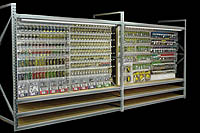
Master Distribution Tomorrow
“Today, manufacturers are requiring more from their distributors than ever before,” remarks Thomas Fontana, division manager for Palermo Supply Co. “This is good news for master distributors. By working with the right ones, a smaller wholesaler is able to reduce overhead and inventory while improving overall customer service.”Although some told us they would find a different business if they had to do it all over again, most master distributors think their role will become even more important in the years to come.
One reason is the increase in imports and outsourcing by PHCP manufacturers, especially with industrial PVF. “The role of the master distributor will definitely increase. It will have to,” comments Industrial Valco's Rob Raban. “The existence of domestic manufacturers is dwindling, so who will supply the product?”
“It's a funny market, because in some years it seems we're more important than in others,” says Metropac's Bryan Cosentino. “But I see it continuing to grow, just because we can service the customers more effectively than a lot of the manufacturers.”
“There's tremendous pressure on companies to reduce inventory,” says Ta Chen's Jeff Larsen. “We have inventory available 24/7, accessible via customers' desktops, and can have it ready to go in an hour. That's like consignment, so yes, master distribution will grow, because there's too much pressure on our customers' cash flow.”
Kessler-Sunbelt's Tim Hagan thinks the future is bright for master distribution, and that pricing will diminish in importance in the years to come. “I think the GMROI craze of the 1990s was a good thing for the industry,” he says. “Wholesalers realized they need to get a return on their investment, and the days of carrying every sku in every size are over. The timeliness of getting product is going to become more important than ever, and the ability to shrink time is going to be the value that we master distributors sell.”
“Our industry is very mature, but there's still a future in a mature industry if you're the best at what you do,” says Specialty Valve & Fitting's Hal Spear.
Sidebar: What Is A Master Distributor?
A common definition of a master distributor in our industry's parlance is that of a distributor who sells to other distributors. But this definition suffers from a lack of precision.For one thing, almost every wholesaler sells at least a little product to fellow wholesalers from time to time when someone needs something in a pinch. Moreover, depending on product lines and other factors, some companies widely regarded as master distributors may sell to other customers besides wholesalers. Some master distributors also manufacture some of the items they sell. Does this make them a manufacturer or a distributor? Some operate other kinds of businesses, such as BAVCO's backflow repair or Kolson's decorative showroom operations.
For the purposes of this article, we've defined master distributors as companies whose main business is selling to conventional PHCP wholesalers, even though they may be involved in other endeavors as well.
